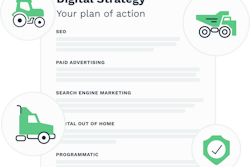Roughly a quarter of owner-operators purchase health insurance on the Affordable Care Act's exchanges, according to the most recent Overdrive polling on the subject. If the current House of Representatives-passed version of the One Big Beautiful Bill Act budget legislation were to become law, many of those owner-operators would face bigger cash outlays to pay for their 2026 ACA plan premiums.
The bill makes a variety of ACA changes, yet didn't extend enhanced subsidies that many ACA plan buyers have benefited from now for four years. Insurance agent Marc Ballard, account manager for the National Association of Independent Truckers' "Truckers Healthcare" clearinghouse for a variety of health benefits to members, said absent changes to the final bill, higher premiums in 2026 are certain. Just how much higher? "Looking at my books, those who have enrolled over the years" in ACA plans "are currently paying under $100 a month" with subsidies taking care of the rest. "A single guy in his 50s or 60s, for instance, who qualifies for greater subsidies because he’s older and income is floating around the $55K or $60K range -- his costs could potentially double."
That's $100 or so extra a month come 2026 -- not exactly life-changing money, but others "will feel a bigger pinch -- families," Ballard added, "with dependents." Depending on a variety of factors, families today pay $200-$400 a month with subsidies. A doubling of their premiums could be a deal-breaker for ACA plan insurance, particularly given an increasing degree of difficulty finding doctors in certain areas who will even accept ACA exchange plans.

The issue originates with the American Rescue Plan legislation, passed early in 2021 and which enhanced subsidies available to buyers of health insurance on the exchanges, depending on their income levels. A year later, the Inflation Reduction Act extended those enhancements through the end of this year. Fundamentally, the enhancements were aimed at preventing some taxpayers from falling off what watchers have called a "subsidy cliff," a level of income above which help on premiums simply wasn't available to purchasers on the exchanges.
That income level, 400% of the federal poverty line, according to the Kaiser Family Foundation, was right around $51,000 annually for a single individual at the time of initial adoption, well less than the roughly $70K the average owner-operator tends to bring in annually. The Rescue Plan capped Silver plan premium costs at 8.5% of income, no matter how high the income, delivering substantial benefits in particular to older Americans with incomes up to $20K and a little more above the old "subsidy cliff."
Overdrive reporting at the time of that legislation showed case examples of how a few different owner-operators stood to benefit, with annual health insurance premium savings between roughtly $4K and $8K.
The 2021 change brought in millions of new health insurance buyers on the exchanges. Kaiser Family Foundation analysis published in 2024 noted that, since 2020, the year prior to enhanced subsidies going into effect, "the number of people with ACA Marketplace coverage" grew "by 88% from 11.4 million to 21.4 million."
For Ballard, "almost everybody we have on the books is getting a subsidy" of some level, most having enrolled in an ACA plan in the time after the Rescue Plan enhanced subsidies. There's plenty that could change in six months from a legislative perspective, Ballard added, yet if the House bill passes as is and nothing else changes "it may not be pretty for a good percentage of these operators" when the new year rolls around.
Near all of the growth cited by KFF was from buyers receiving subsized health insurance. As Senators take up the bill, reporting suggests some Republican members have shown favor for extending the enhanced subsidies, and states who run their own health insurance exchanges have been considering ways to potentially make up the difference for buyers there to avoid an exodus from the insurance exchanges.
Ballard suggested short-term medical options, expanded during President Trump's first term but curtailed in some ways under the Biden administration, could help fill the gap as a more-affordable option for healthy people who don't need to cover pre-existing conditions -- a key feature of exchange plans.
Today "in a lot of states there are no short-term medical options," Ballard said. "If we go back toward that being more meaty" in terms of coverage and avaialbility, "that could be a solution" to higher exchange-plan costs next year. "Yet given short-term medical will exclude [coverage of] pre-existing conditions," those who need health insurance the most will probably need "to stay where they’re at" in an exchange plan, and just take the cost hit.
In 2024, the Congressional Budget Office analyzed how failure to extend the enhanced premium subsidies beyond calendar year 2025 could impact participation in the exchanges generally, estimating an immediate reduction in health-plan purchases as buyers are priced out. In that 2024 analysis, according to KFF, enrollment was projected to fall from "22.8 million in 2025 to 18.9 million the following year. ... reaching as low as 15.4 million in 2030."
The sunset of enhanced subsidies isn't the only ACA-related change that could result if the House bill were to be passed. As Senators debate provisions, you can track those related to the health insurance exchanges via this link to KFF's explainer.
[Related: Health insurance savings possible for many more owner-operators after Rescue Plan legislation]













